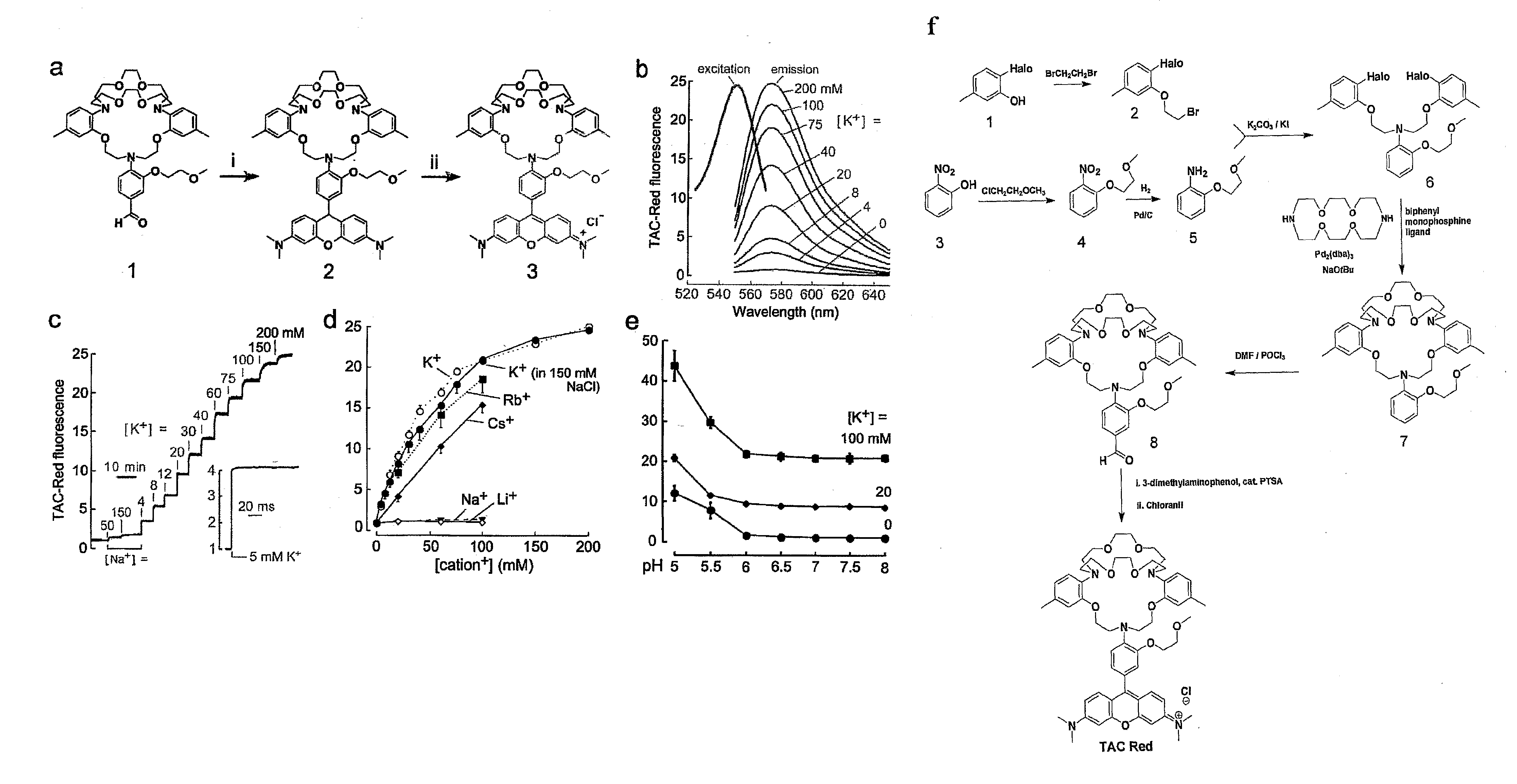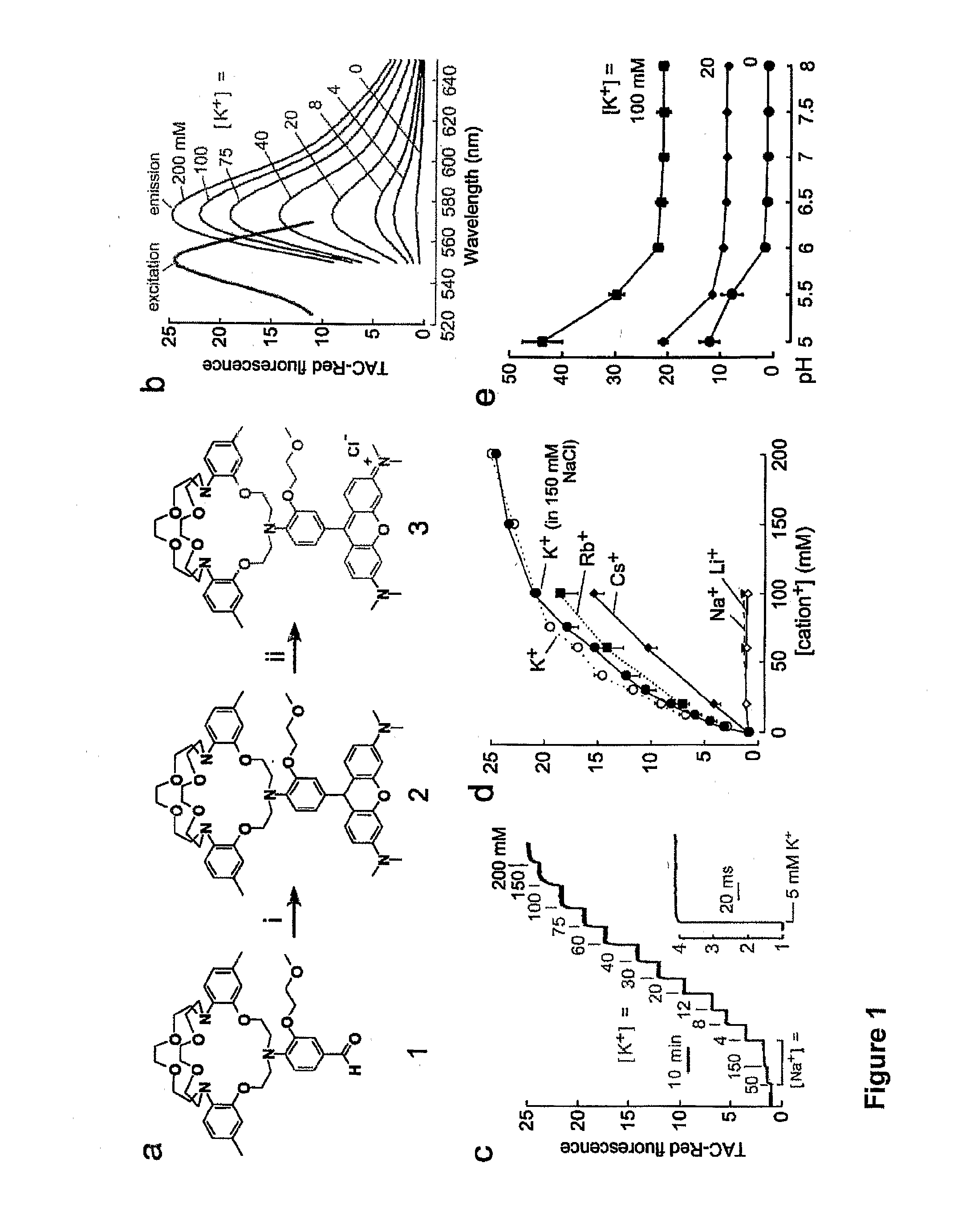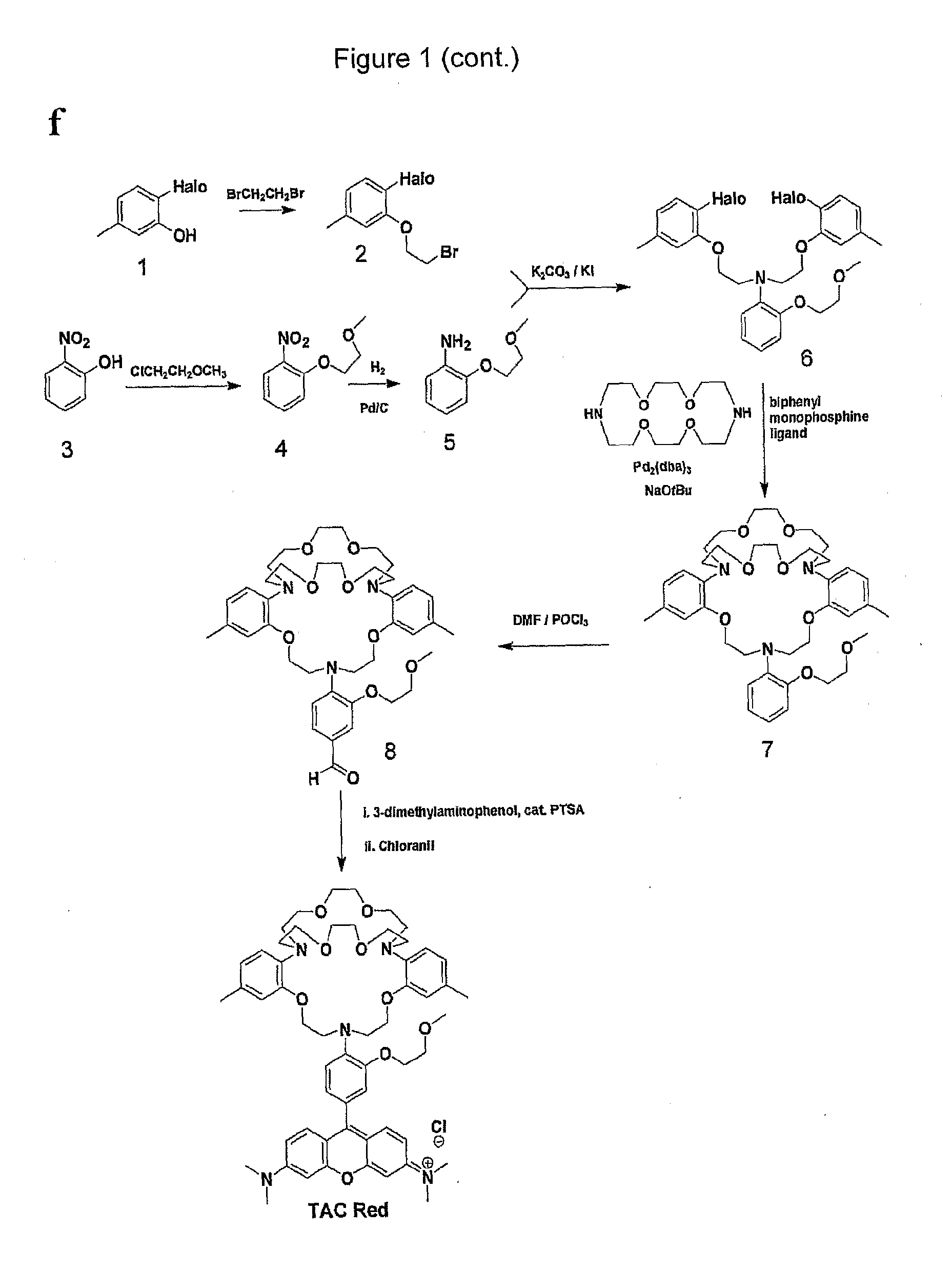Water-Soluble, Fluorescent Compounds for Detection of Potassium Ions
a fluorescent compound and potassium ion technology, applied in the field of water-soluble fluorescent compounds for detection of potassium ions, can solve the problems of high ph sensitivity, high fabrication difficulty, and difficult ksup>+/sup> concentration assessment, and achieve the effect of increasing fluorescence and short time period
- Summary
- Abstract
- Description
- Claims
- Application Information
AI Technical Summary
Benefits of technology
Problems solved by technology
Method used
Image
Examples
example 1
TAC Red Conjugate and Spectroscopic Analysis
[0345]FIG. 1, Panel a provides a schematic of the synthesis of the TAC-Red chromoionophore of the invention. Aldehyde ionophore 1 was synthesized as described in He et al. J. Am. Chem. Soc. 125, 1468-1469 (2003). TAC-Red was synthesised by condensation of 3-dimethylaminophenol with ionophore 1 to give compound 2, which on oxidation with tetrachloro-1,4-benzoquinone gave TAC-Red 3.
[0346]Compound 2, 9-[4-(6,7,9,10,12,13,20,21,23,24-decahydro-2,17-dimethyl-5,14-(ethanoxyethanoxyethano)-5H,14H,22H-dibenzo[h,q][1,4,10,16,7,13,19]tetraoxatriazacyclo-heneicosin-22-yl)-3-(2-methoxyethoxy)phenyl]-N,N,N′,N′-tetramethyl-9H-xanthene-3,6-diamine, was synthesized by stirring aldehyde 1 (100 mg, 0.138 mmol) and 3-dimethylaminophenol (41 mg, 0.303 mmol) in 5 ml propionic acid with catalytic amount p-toluene sulfonic acid (PTSA) for 20 h at 60° C. After cooling, compound 2 was precipitated with 3M sodium acetate and the precipitated solid was collected by ...
example 2
TAC-Julolidine Red or TAC-Crimson Conjugate
[0354]FIG. 9 provides a schematic for synthesis of TAC-Julolidine Red (TAC-Jr or TAC-Crimson) (1H,5H,11H,15H-Xantheno[2,3,4-ij:5,6,7-i′j′]diquinolizin-18-ium, 9-[4-(6,7,9,10,12,13,20,21,23,24-decahydro-2,17-dimethyl-5,14-(ethanoxyethanoxyethano)-5H,14H,22H-dibenzo[h,q][1,4,10,16,7,13,19]tetraoxatriazacycloheneicosin-22-yl)-3-(2-methoxyethoxy)phenyl]-2,3,6,7,12,13,16,17-octahydro-, chloride).
[0355]Compound 2 of FIG. 9 was synthesized by stirring aldehyde 1 (72 mg, 0.10 mmol) and 8-hydroxyjulolidine (41 mg, 0.22 mmol) in 1 ml propionic acid with catalytic amount p-toluene sulfonic acid (PTSA) for 20 h at 60 to 70° C. After cooling, compound 2 was precipitated with 3M sodium acetate and the precipitated solid was collected by centrifugation, washed with water and dried, giving approximately 0.106 gm of a brownish-rose coloured solid, which was used immediately for subsequent reaction.
[0356]TAC-Julolidine Red or TAC-Crimson (TAC-Jr) 3, was synt...
example 3
TAC-Rhodamine Conjugate
[0358]A TAC-Rhodamine conjugate can be synthesized to provide a conjugate having desired characteristics of potassium sensitivity and long wavelength (e.g., excitation above about 500 nm).
[0359]FIG. 11 provides a schematic of an exemplary synthetic scheme which can be used to synthesize a TAC-Rhodamine conjugate of the invention. In general, the synthetic scheme for TAC-Rhodamine will be similar to that for TAC-Red and TAC-Julolidine Red or TAC-Crimson, except the starting aminophenol derivative 2 (FIG. 11) which can be synthesized according to the procedure described by Liu et. al. in Tetrahedron Lett. 44:4355-4359 (2003). A schematic for an exemplary synthetic scheme for the aminophenol derivative is set out in FIG. 12.
PUM
| Property | Measurement | Unit |
|---|---|---|
| Concentration | aaaaa | aaaaa |
| Structure | aaaaa | aaaaa |
| Solubility (mass) | aaaaa | aaaaa |
Abstract
Description
Claims
Application Information
 Login to View More
Login to View More - R&D
- Intellectual Property
- Life Sciences
- Materials
- Tech Scout
- Unparalleled Data Quality
- Higher Quality Content
- 60% Fewer Hallucinations
Browse by: Latest US Patents, China's latest patents, Technical Efficacy Thesaurus, Application Domain, Technology Topic, Popular Technical Reports.
© 2025 PatSnap. All rights reserved.Legal|Privacy policy|Modern Slavery Act Transparency Statement|Sitemap|About US| Contact US: help@patsnap.com



